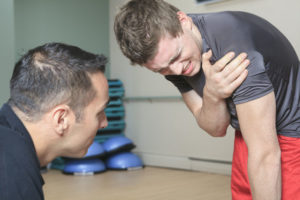It’s that time of year when flushed with the desire to get back to it after a bit of a break over the festive period can result in you getting injured. Avoiding injuries is paramount to any kind of sustainable progress, even more so as we get older. Given that you are always likely to pick one up at some point it rather than fire back into things after the holidays it’s a far better idea to ease yourself back into things.
I did this myself November and wasted about 3 weeks of training, though thankfully no injury. I say thankfully as I was coming back from a slight quad tear. It took me 3 weeks to realise that I needed to adjust things down. The rest period I had just had was on the back of having peaked as well as the quad tear. As a result, I had the general deconditioning that occurs after a rest period plus there was the normal drop in performance from the peak itself.
ACUTE-CHRONIC WORKLOAD RATIO.
One of the first things you should look at to make avoiding injuries easier is the acute to chronic workload. This is an idea popularised by Tim Gabbett, whom I have talked about before. It is, in simple terms, where you increase your training load too dramatically and really increase your chances of injury as a result.
Whilst this can apply to this time of year it can be anytime you’ve been training irregularly or with a much lower volume than normal. You lose some conditioning and really aren’t at top speed so you need to give yourself a chance to get back into shape before pushing harder again.
The flip side is where you push hard for too long. The chronic stress gets too high and you can again increase your chances of injury. This isn’t overtraining which requires a significantly higher degree of stress but rather just wearing something out.
The key is to get this ratio correct. Strength train and train specifically for your sport. Train hard enough and recover well then before an acute load (e.g. a big race, competition or goal you’ve been chasing ) reduce the amount you are doing and get more rest before that event.
STRENGTH TRAIN.
One of the best things you can do to avoid getting injured is to get stronger. Strength training has been shown to reduce the chances of getting an injury by around 70%. The more load you ask your body to cope with, the more load it becomes able to withstand. This also has the added benefit of improving your sporting performance.
Even distance runners can benefit from it. WIth a number of studies showing significant benefits in terms of performance. One such study showed that a group of sub-elite distance runners, VO2 max of 60, saw an increase of 4% in theirVO2 max from a period of strength training.
CONDITIONING WORK
The flip side of strength training is conditioning work. Be it running, cycling, rowing or whatever method you choose you should be doing some. Aerobic work has great benefits in terms of aiding recovery even if you aren’t a runner or cyclist. Everything we do is based on the aerobic system so having an underdeveloped one is leaving results going to waste.
SLEEP, NUTRITION & HYDRATION.
Don’t underestimate the power of quality sleep. Aim for a bare minimum of 6 hours and ideally 8 hours. Why this figure? It has been shown in a number of studies that less than 6-8 hours sleep will result in a 10-30% drop in performance. You are also much more likely to notice little aches and pains as a result of increased sensitivity. This increase in sensitivity comes from your stress levels increasing, due to the lack of sleep.
Sound nutrition is the second of the two most important building blocks of a solid recovery strategy. This isn’t complicated nor does it require a dietitian. 3-4 solid meals a day that revolves around covering the major food groups and cover your calorie requirements. You can’t go far wrong with a meat and two veg approach to your meals.
If you would like to arrange a phone to have a chat about any issues that have been raised here please click here. Or if you would like to arrange an appointment please click here.


